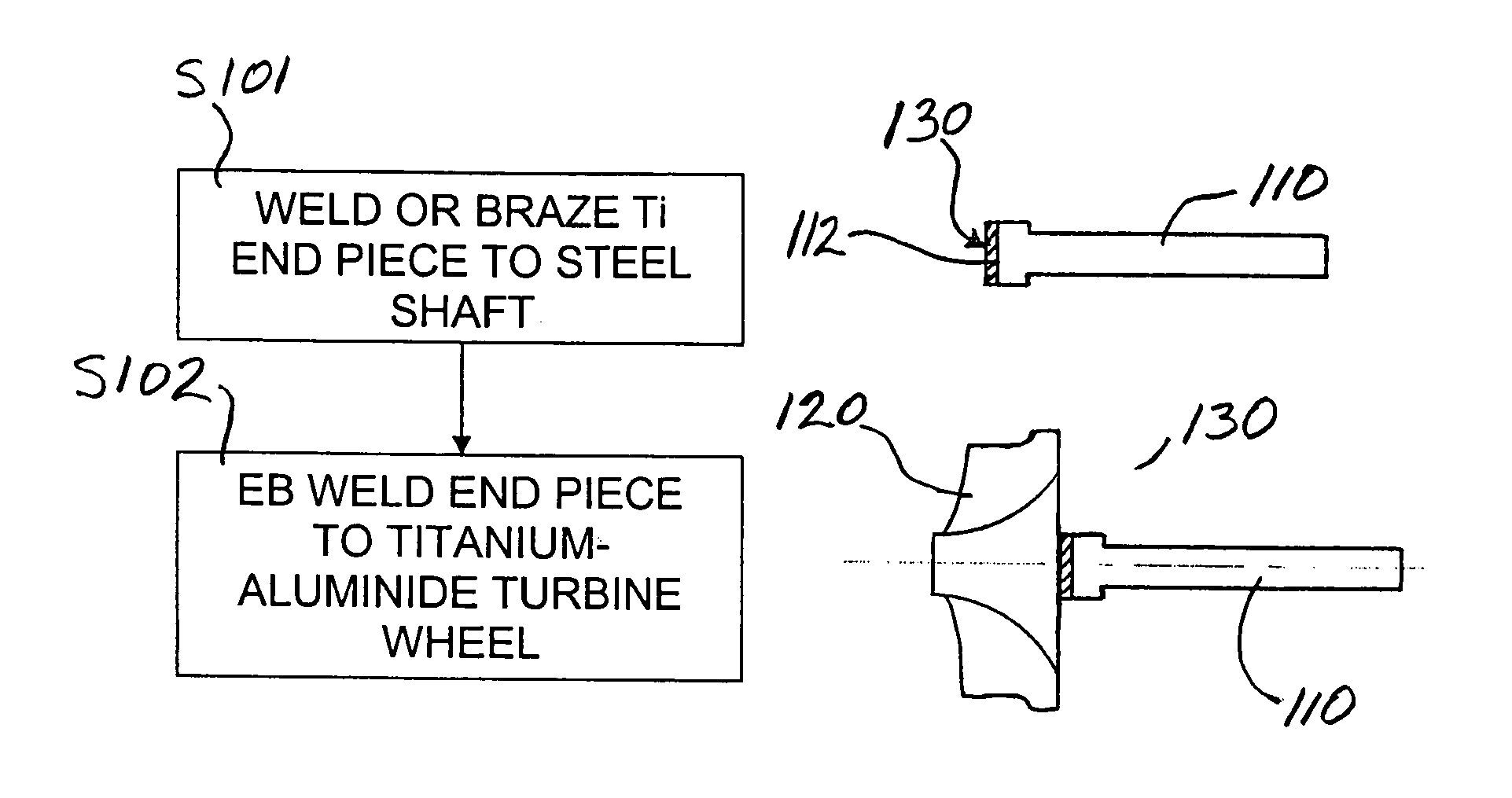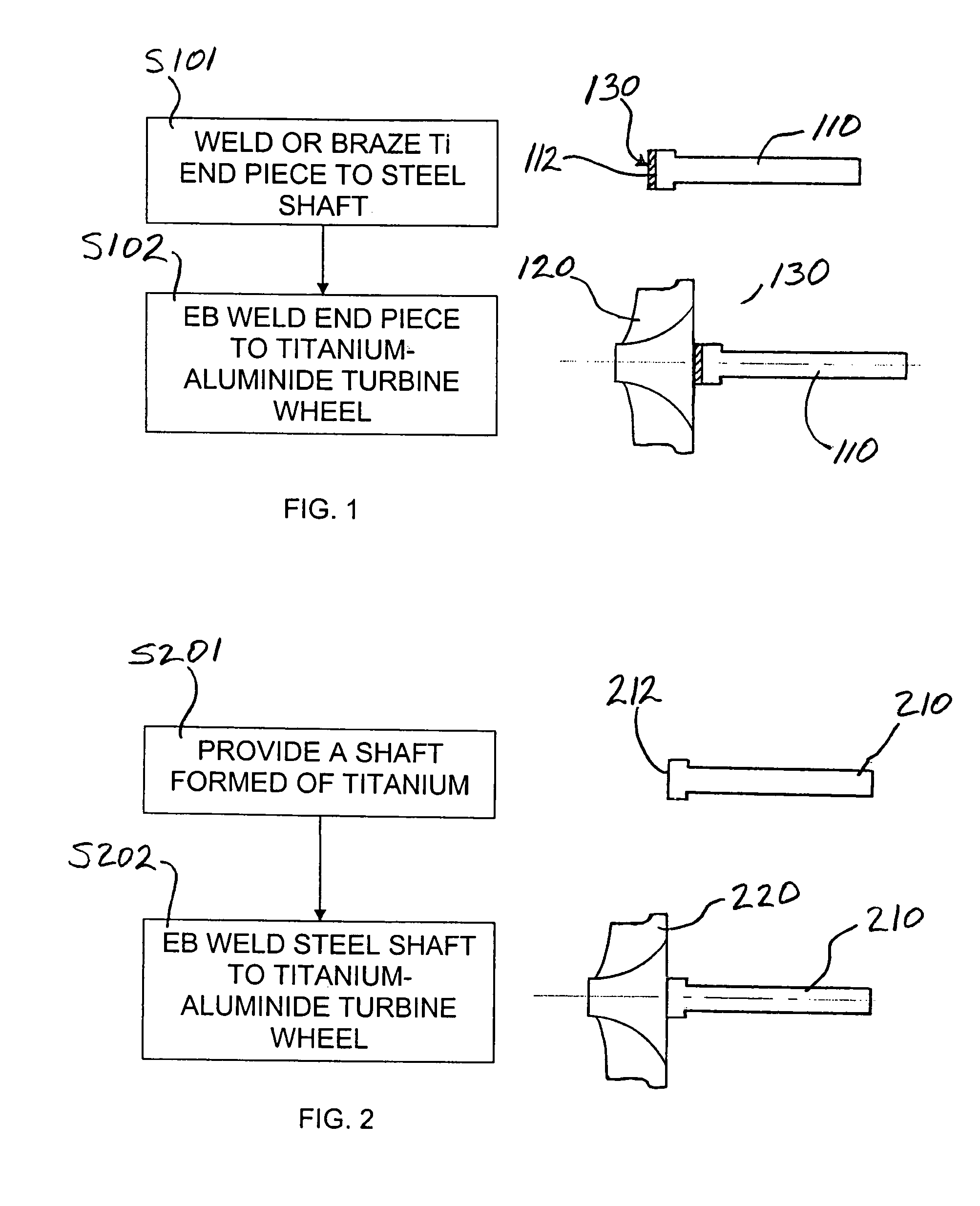Titanium-aluminide turbine wheel and shaft assembly, and method for making same
a technology of titanium aluminum and turbine wheels, which is applied in the field of titanium aluminum turbine wheels and shaft assemblies, and the method of making same, and turbochargers, and can solve the problems of poor oxidation and creep resistance, poor high-temperature strength, and brittle alpha-2 phas
- Summary
- Abstract
- Description
- Claims
- Application Information
AI Technical Summary
Benefits of technology
Problems solved by technology
Method used
Image
Examples
first embodiment
[0019]With reference to FIG. 1, the invention is illustrated. A steel shaft 110 is provided for joining with a titanium-aluminide turbine wheel 120. The shaft 110 can comprise a medium-carbon low alloy steel. The shaft has a joint surface 112 at its end for attachment to the turbine wheel. The turbine wheel can be formed of any of various titanium-aluminide intermetallic compounds.
[0020]In accordance with the first embodiment of the invention, an end piece 130 is provided as an intermediary between the steel shaft 110 and the titanium-aluminide turbine wheel 120. The end piece 130 is a titanium-containing member, and advantageously can comprise a substantially pure form of titanium or a titanium alloy. The end piece can be of various configurations such as in the form of a ring, a disk, or a slab. In a first step S101, the end-piece 130 is mechanically joined (brazed, bonded, or welded) to the shaft at the joint surface 112 and thus becomes a part of the shaft. The result of the fir...
second embodiment
[0022]FIG. 2 illustrates the invention. A shaft 210 formed of titanium or titanium alloy is provided in a first step S201. For example, the shaft can be milled from titanium bar stock or titanium alloy bar stock. The shaft has a joint surface 212 for attachment to a turbine wheel. In a second step S202, a titanium-aluminide turbine wheel 220 is welded to the joint surface 212 of the shaft 210, such as by electron beam welding. The wheel is thus joined to the shaft to form a shaft assembly.
third embodiment
[0023]the invention is depicted in FIG. 3. In a first step S301, a ferrous end piece 330 is brazed to a titanium-aluminide turbine wheel 320. The end piece can comprise various ferrous-based materials, including but not limited to A286, HY-130, or HP9-4-20. In a second step S302, the ferrous end piece 330 is mechanically joined (brazed, bonded, or welded) at a joint surface 312 to a steel shaft 310. The shaft can be formed of various steel compositions. A suitable steel is a medium-carbon low alloy steel. The end piece 330 can be welded to the shaft 310 by electron beam welding. The wheel is thus joined to the shaft to form a shaft assembly.
PUM
| Property | Measurement | Unit |
|---|---|---|
| speed | aaaaa | aaaaa |
| melting point | aaaaa | aaaaa |
| temperature | aaaaa | aaaaa |
Abstract
Description
Claims
Application Information
 Login to View More
Login to View More - R&D
- Intellectual Property
- Life Sciences
- Materials
- Tech Scout
- Unparalleled Data Quality
- Higher Quality Content
- 60% Fewer Hallucinations
Browse by: Latest US Patents, China's latest patents, Technical Efficacy Thesaurus, Application Domain, Technology Topic, Popular Technical Reports.
© 2025 PatSnap. All rights reserved.Legal|Privacy policy|Modern Slavery Act Transparency Statement|Sitemap|About US| Contact US: help@patsnap.com



